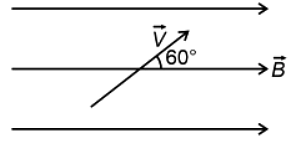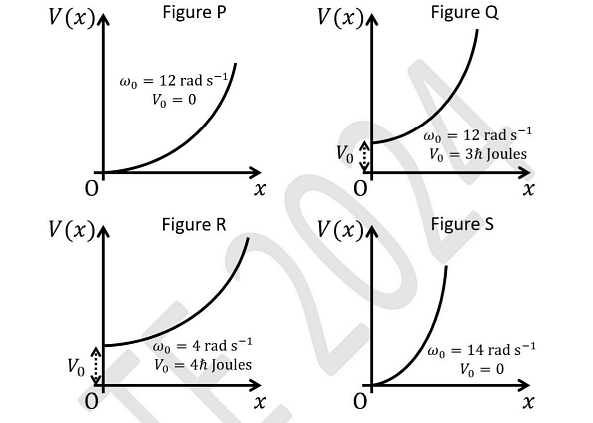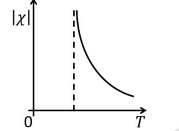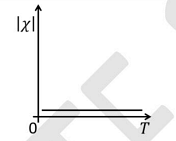A proton is projected with speed v in magnetic field B of magnitude 1 T. The angle between velocity and magnetic field is 600 as shown below. The kinetic energy of a proton is 2 eV (mass of proton = \(1.67\times10^{-27} kg\), e = \(1.6\times10^{-19}\)C). The pitch of the path of the proton is approximately?

A proton is projected with speed v in magnetic field B of magnitude 1 T. The angle between velocity and magnetic field is 600 as shown below. The kinetic energy of a proton is 2 eV (mass of proton = \(1.67\times10^{-27} kg\), e = \(1.6\times10^{-19}\)C). The pitch of the path of the proton is approximately?
- 6.28 x 10-2 m
- 6.28 x 10-4 m
- 3.14 x 10-2 m
- 3.14 x 10-4 m
The Correct Option is B
Approach Solution - 1
\(R = \frac{mv\, sin60^{\circ}}{qB}\)
\(T-\frac{2\pi m}{qB}\,\,\,\,\,K.E = -\frac{1}{2}mv^2\)
pitch = \(v\,cos\theta\times(\frac{2\pi m}{qB})\,\,\,\,\,\,\,\,\sqrt{\frac{2K}{M}}=v\)
\(\sqrt{\frac{2K}{M}}\times\frac{1}{2}\times\frac{2\pi m}{qB}\)
= \(\frac{\pi}{eB}.\sqrt{2Km}=\frac{3.14}{1.6\times10^{-19}\times1}\times\sqrt{2\times2\times(1.6)^2\times10^{-46}}\)
\(=\frac{3.14}{1.6\times10^{-19}}\times2\times1.6\times10^{-23}\)
\(=6.28\times10^{-4}m\)
Approach Solution -2
F = q v x B
where q is the charge of the particle, v is its velocity, and B is the magnetic field. The direction of the force is perpendicular to both v and B and is given by the right-hand rule.
The magnitude of the force is given by:
|F| = q v B sinθ
where θ is the angle between v and B.
Since the proton is moving perpendicular to the magnetic field, the angle θ is 90 degrees and sinθ is equal to 1. Therefore, the magnitude of the force on the proton is:
|F| = q v B
The force causes the proton to move in a circular path with radius r, given by:
\(|F| = \frac{(m v^2)}{r}\)
where m is the mass of the proton.
Equating the two expressions for |F|, we get:
\(qvB= \frac{(m v^2)}{r}\)
Solving for r, we get:
\(r = \frac{m v}{(q B)}\)
Substituting the given values, we get:
r = \((1.67 x 10^{-27} kg) \frac{\sqrt{2 x 1.6 x 10^{-19} J}} {1.6 x 10^{-19} C x 1 T}\)
r = 6.28 x 10-4 m
Therefore, the pitch of the path of the proton is approximately 6.28 x 10-4 m.
Hence, the correct option is (B) 6.28 x 10-4 m.
Answer. B
Top Questions on Magnetism and matter
- A particle of mass m is moving in the potential
\[ V(x) = \begin{cases} V_0 + \frac{1}{2} m \omega_{0P}^2 x^2 & \quad \text{if } x > 0 \\\infty & \quad \text{if } x \leq 0 \end{cases}\]
Figures P, Q, R, and S show different combinations of the values of \( \omega_0 \) and \( V_0 \).
Let \( E^{(P)}_j \), \( E^{(Q)}_j \), \( E^{(R)}_j \), and \( E^{(S)}_j \) with \( j = 0, 1, 2, \ldots \), be the eigen-energies of the j-th level for the potentials shown in Figures P, Q, R, and S, respectively. Which of the following statements is/are true?- GATE PH - 2024
- Physics
- Magnetism and matter
- A material behaves as a superconductor below a critical temperature \( T_c \) and as a normal conductor above \( T_c \). A magnetic field \(\overrightarrow{B} = B\hat{z}\) is applied when \( T > T_c \). The material is then cooled below \( T_c \) in the presence of \( \vec{B} \). Which of the following figures represents the correct configuration of magnetic field lines?
- GATE PH - 2024
- Physics
- Magnetism and matter
- The temperature \( T \) dependence of magnetic susceptibility \( \chi \) (Column I) of certain magnetic materials (Column II) are given below. Which of the following options is/are correct?
Column I Column II (1) 
(P) Diamagnetic (2) 
(Q) Paramagnetic (3) 
(R) Ferromagnetic (4) 
(S) Antiferromagnetic - GATE PH - 2024
- Physics
- Magnetism and matter
- An infinite one-dimensional lattice extends along the x-axis. At each lattice site, there exists an ion with spin 1/2. The spin can point either in the +z or -z direction only. Let \( S_P \), \( S_F \), and \( S_A \) denote the entropies of paramagnetic, ferromagnetic, and antiferromagnetic configurations, respectively. Which of the following relations is/are true?
- GATE PH - 2024
- Physics
- Magnetism and matter
- The Curie temperatures of Cobalt and iron are 1400K and 1000K respectively. At T = 1600K , the ratio of magnetic susceptibility of Cobalt to that of iron is
- KCET - 2023
- Physics
- Magnetism and matter
Questions Asked in JEE Main exam
- If the 20th term from the end of the progression 20,19\({\frac{1}{4}}\) ,18\({\frac{1}{2}}\) ,17\({\frac{3}{4}}\) ,……, -129\({\frac{1}{4}}\) is______?
- JEE Main - 2024
- Arithmetic Progression
- A body of mass 1000 kg has a velocity of 6 m/s. If an extra 2000 kg mass is embedded in it, then what will be the velocity of the combined mass?
- JEE Main - 2024
- speed and velocity
- Rank of the word 'GTWENTY' in dictionary is _____ .
- JEE Main - 2024
- permutations and combinations
- In a 64 terms GP if sum of total terms is seven times sum of odd terms, then common ratio is:
- JEE Main - 2024
- Geometric Progression
- In a paper there are 3 sections A, B and C which have 8, 6 and 6 questions each. A student have to attempt 15 questions such that they have to attempt at least 4 questions out of each sections. Then number of ways of attempting these questions are
- JEE Main - 2024
- Permutations
JEE Main Notification
 ICAI Announces CA January 2025 Exam ScheduleSep 21, 2024
ICAI Announces CA January 2025 Exam ScheduleSep 21, 2024Concepts Used:
Magnetism & Matter
Magnets are used in many devices like electric bells, telephones, radio, loudspeakers, motors, fans, screwdrivers, lifting heavy iron loads, super-fast trains, especially in foreign countries, refrigerators, etc.
Magnetite is the world’s first magnet. This is also called a natural magnet. Though magnets occur naturally, we can also impart magnetic properties to a substance. It would be an artificial magnet in that case.
Read More: Magnetism and Matter
Some of the properties of the magnetic field lines are:
- The lines and continuous and outside the magnet, the field lines originate from the North pole and terminate at the South pole
- They form closed loops traversing inside the magnet.
- But here the lines seem to originate from the South pole and terminate at the North pole to form closed loops.
- More number of close lines indicate a stronger magnetic field
- The lines do not intersect each other
- The tangent drawn at the field line gives the direction of the field at that point.



